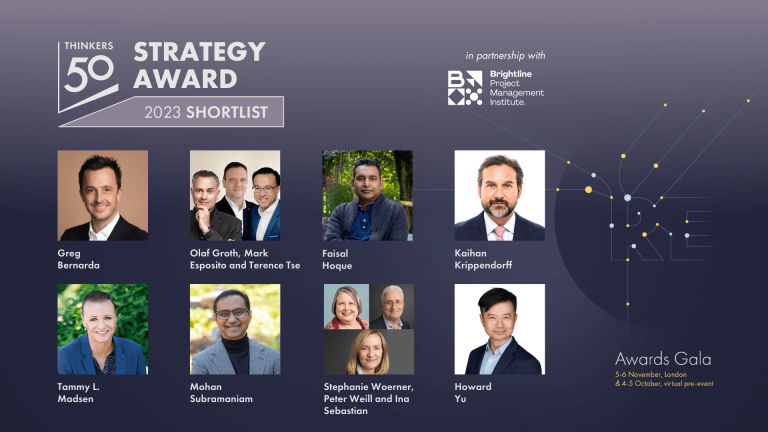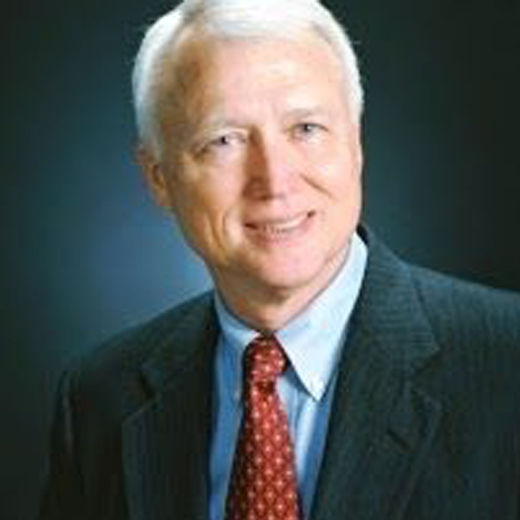

by Jim Underwood DBA, MBA, MA.
The television commercial featured an elderly woman with a cracked voice holding a hamburger. In her hand was a large bun with a miniscule excuse for a hamburger patty. “Where’s the beef?” she shouted.
That commercial was one of the most successful of the 1980’s. It became the standard for expressing disdain for just about anything that involved big promises and low levels of benefit. Would it be fair to ask “Where’s the beef?” when it comes to the strategic concepts introduced over the past 20-30 years?
Sadly, the answer is a resounding “yes”. Beginning with In Search of Excellence and concluding with the current state of strategy, it is fair to say that the landscape is populated with the remains of companies that apparently characterized each of the concepts, yet failed to perform as promised by the author of the construct (or bestselling book). The year 2013 was perhaps the “defining moment” related to the problems with the field of strategy. The Harvard Business School Press published The End of Competitive Advantage while the consulting firm of one of the concept’s most published proponents went into bankruptcy.
The Missing Foundation: Systems
While most of the world operates with a fairly realistic understanding of systems, the world of business strategy rarely delves into that area. Think about it: Would you attempt to take the old America’s Cup yacht France I and compete in the next America’s cup race? Of course not; the competitive system in the America’s Cup has radically changed. Would you be willing to take the latest hybrid car from Toyota and compete in a Grand Prix race? Aside from being suicidal, that would also guarantee a losing race.
When it comes to all of the strategic constructs of the last 30 years, what is the implied promise? Answer: If you use this methodology your company will perform much better. Now, let’s take a look at that promise from a systems standpoint:
If you consider the various constructs that have involved corporate strategy, we find that all have been based on a succession of metaphors. Competitive advantage (or the resource-advantage view) is metaphorical adaptations of Smith’s equilibrium theory and Ricardo’s comparative advantage. Much of Senge’s and Wheatley’s work is based on a metaphorical adaptation of Darwin’s work. Mintzberg and Stacey’s work is derived from Simon’s work on “bounded rationality”.
A Systems Perspective of Hypothesis
In my work on systems, I have developed a concept called a “representative construct.” A representative construct is one that allows one to accurately describe, predict, or manipulate a system. In the late 1800s when Joseph Lister hypothesized that the cross contamination between surgical instruments, surgeons’ hands, and surgical patients was the problem with the high number of post surgery infection deaths, he was ridiculed. Of course, it wasn’t long until he was proven right. Thus, his hypothesis met the requirements and may be categorized as a “representative construct” of a system.
In the same manner, Langerhans, in 1869 hypothesized that certain cells in the pancreas secrete insulin, and thus are directly related to the disease. Now known as the “Islets of Langerhans” we again note that his hypothesis can be categorized as a representative construct.
Now let’s go back to the problems related to the last 30 years of corporate strategy. Can any meet the standard by which they can be categorized as a representative construct? Sadly, the evidence reveals that none of the above-cited concepts meets that standard.
Be sure to note that those entire hypothesis failed because they did not align with the reality of the system. Go back to the yacht racing scenario or the grand prix scenario. The problem is not that France I is not a great yacht, or that a Toyota hybrid is not a great car. It is simply the problem that neither was designed for the context or competitive system that they were to face. A system (such as a firm) fails because it does not align with the system in which it is operating.
Strategy: A Representative Construct
H. Igor Ansoff’s research covered a period of over 30 years. A Ph.D. in mathematics, he believed that it is possible to measure the competitive ability of organizations using a metric that was based on research that focuses on organizational performance and organizational capabilities. Unlike other approaches, Ansoff believed that strategy must be designed around context (competition). In 1993, along with a team of doctoral candidates (and graduates), his research summary was published in the International Review of Strategic Management (“Empirical Proof of a Paradigmic Theory of Strategic Success Behaviors of Environment Serving Organizations”). What Ansoff had done with the assistance of his doctoral students was to affirm that his “strategic success hypothesis” had been validated as a theorem. In other words, Ansoff created the first “representative construct” in the field of strategy. It should be noted that Ansoff’s research revealed that aligned companies had ROI’s of 100% to 300% higher than non-aligned companies.
Performance Implications
In 2001, I began work on expanding the Ansoff model from 8 categories (marketing, innovation, management, culture, etc.) to a 17 category model (Includes factors like ethics, etc.). The challenge with the model is that to get good data on an organization, an internal questionnaire must be administered. In conducting my original research on the expanded model, I was able to get internal feedback from 15 firms from various industries. The scoring is based on a possible 170 points. The scores for the 15 companies ranged from a low of 40 to a high of 167. The result was a very high correlation between each company’s score and their industry ranking. Those with scores of 150 and above ranked in the top 20% in financial performance, while those below 80 ranked in the bottom 20%.
I was then able to gain internal access to ten of America’s top performing companies. Those companies generally scored above 150.
Over the past 20 years I have supervised over 1,000 graduate consulting studies for numerous companies. Of those companies, over 200 were Fortune 500 companies. The graduate teams were consistently able to predict the future performance of the companies. In a number of cases, they accurately predicted the future bankruptcy of clients.
I have continued my work with the model in developing a “performance algorithm”. My work with a division of IBM produced a 34% revenue increase for the client division while the other six non-client divisions had no revenue increase. I have seen similar results in working with other global organizations.
One of my favorite stories about the use of the model came out of a doctoral student’s study of 15 banks. His research indicated that 8 of the banks had significant misalignments, and that 7 were strategically aligned. Four years after graduating, he went back to check on the banks to see just how accurate the model was. The 8 non-aligned banks had gone bankrupt. The 7 were still profitable and doing quite well.
My hope is that our field will move from a static approach that is based on linear modeling to more contingency-based approaches such as that discovered by Ansoff. I am encouraged to see the work by people like Donald Sull who is leading the charge in this area.
Jim Underwood is a Professor of Management at Dallas Baptist University. He is the author of over 15 books, including one New York Times bestselling book and one international award winning book. He served as the Global Strategy Content Expert for the Nortel Learning Institute. His clients include Sprint PCS, IBM, Bell Northern Research, McKesson Pharmaceuticals, J & J, and numerous others.

Thinkers50 Limited
The Studio
Highfield Lane
Wargrave RG10 8PZ
United Kingdom

Thinkers50 Limited
The Studio
Highfield Lane
Wargrave RG10 8PZ
United Kingdom

| Cookie | Duration | Description |
|---|---|---|
| LANG | 9 hours | Linkedin set this cookie to set user's preferred language. |
| nsid | session | This cookie is set by the provider PayPal to enable the PayPal payment service in the website. |
| sp_landing | 1 day | The sp_landing is set by Spotify to implement audio content from Spotify on the website and also registers information on user interaction related to the audio content. |
| sp_t | 1 year | The sp_t cookie is set by Spotify to implement audio content from Spotify on the website and also registers information on user interaction related to the audio content. |
| tsrce | 3 days | PayPal sets this cookie to enable the PayPal payment service in the website. |
| x-pp-s | session | PayPal sets this cookie to process payments on the site. |
| __cf_bm | 30 minutes | This cookie, set by Cloudflare, is used to support Cloudflare Bot Management. |
| Cookie | Duration | Description |
|---|---|---|
| l7_az | 30 minutes | This cookie is necessary for the PayPal login-function on the website. |
| Cookie | Duration | Description |
|---|---|---|
| CONSENT | 2 years | YouTube sets this cookie via embedded youtube-videos and registers anonymous statistical data. |
| _ga | 2 years | The _ga cookie, installed by Google Analytics, calculates visitor, session and campaign data and also keeps track of site usage for the site's analytics report. The cookie stores information anonymously and assigns a randomly generated number to recognize unique visitors. |
| _gat_gtag_UA_10408481_1 | 1 minute | Set by Google to distinguish users. |
| _ga_ZP8HQ8RZXS | 2 years | This cookie is installed by Google Analytics. |
| _gid | 1 day | Installed by Google Analytics, _gid cookie stores information on how visitors use a website, while also creating an analytics report of the website's performance. Some of the data that are collected include the number of visitors, their source, and the pages they visit anonymously. |
| Cookie | Duration | Description |
|---|---|---|
| NID | 6 months | NID cookie, set by Google, is used for advertising purposes; to limit the number of times the user sees an ad, to mute unwanted ads, and to measure the effectiveness of ads. |
| test_cookie | 15 minutes | The test_cookie is set by doubleclick.net and is used to determine if the user's browser supports cookies. |
| VISITOR_INFO1_LIVE | 5 months 27 days | A cookie set by YouTube to measure bandwidth that determines whether the user gets the new or old player interface. |
| YSC | session | YSC cookie is set by Youtube and is used to track the views of embedded videos on Youtube pages. |
| yt-remote-connected-devices | never | YouTube sets this cookie to store the video preferences of the user using embedded YouTube video. |
| yt-remote-device-id | never | YouTube sets this cookie to store the video preferences of the user using embedded YouTube video. |
| yt.innertube::nextId | never | This cookie, set by YouTube, registers a unique ID to store data on what videos from YouTube the user has seen. |
| yt.innertube::requests | never | This cookie, set by YouTube, registers a unique ID to store data on what videos from YouTube the user has seen. |
| Cookie | Duration | Description |
|---|---|---|
| DEVICE_INFO | 5 months 27 days | No description |
| loglevel | never | No description available. |
| m | 2 years | No description available. |
Thinkers50 Limited has updated its Privacy Policy on 28 March 2024 with several amendments and additions to the previous version, to fully incorporate to the text information required by current applicable date protection regulation. Processing of the personal data of Thinkers50’s customers, potential customers and other stakeholders has not been changed essentially, but the texts have been clarified and amended to give more detailed information of the processing activities.